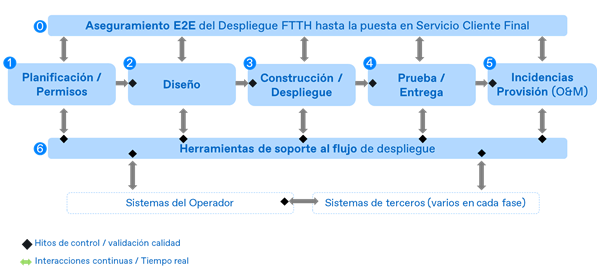Article
How a fiber rollout is organized

From planning to provisioning, we analyze the phases of an FTTH rollout
Spain, where 89% of properties have access to high-speed fiber optic service, is ranked as one of the countries with the most fiber penetration in the world.
Nae has participated in the alternative broadband rollouts in Spain, where it has led projects that have impacted over 30 million households and advised major funds and private equity in their fiber investment transactions.
Based on our experience in this field, the success of an FTTH (Fiber to the Home) rollout depends primarily on the organizational model used to manage it. The following article explains the phases that a fiber rollout should include.

1. Planning and requesting permits
This is the initial phase of a rollout and the foundation for all subsequent tasks. As a result, the work for defining the areas to be built, requesting permits and reevaluating on the ground must be done meticulously. The definition process applies target market criteria, analyzing the competitors and rollout costs (urban versus rural) to select the target areas for the rollout.
To reduce costs and shorten rollout timeframes, framework agreements must be signed with infrastructure owners and operators that can be called on to lay the cables and install the equipment.
Requesting permits and reevaluating on the ground in the selected areas make it possible to rule out buildings that are not viable or will entail cost overruns, as well as to confirm the actual number of properties. Given the differences between cartographic databases and reality, this last aspect can endanger the rollout’s profitability.
Lastly, the permit threshold by area for commencing the rollout must be defined, thereby guaranteeing the validity of the proposed design and the future execution of work in the field. The deliverable for this phase is a detailed inventory of the network footprint to be rolled out, making it possible to plan and adjust the rollout costs.
2. FTTH network design
Once the defined permit threshold has been reached, the design work commences.
There are very different solutions for designing an FTTH network. However, based on our experience, we recommend adopting a production model based on creating an engineering station. Operating under the principle of quality over speed, and backed by a single document manager and a centralized GIS (geographic information system) database, it ensures the availability and consistency of information, and helps quicken the release to production.
This model guarantees compliance with standardized design criteria throughout the network (division level, penetration index, etc.) and contributes to a high degree of technical specialization for all the parties involved in the process.
By including a cost and quality review through an independent BQA (build quality assurance), the resulting design factory improves the process efficiency (properties designed versus those accepted) by more than 7% and optimizes the capital expenditure per household.
3. Construction and rollout
The predominant construction model is based on an ecosystem of contractors specialized in public works and telecommunications installations, and that do not work exclusively for a telecommunications provider.
Therefore, given the existing dependency, long-term plans must be made that guarantee a constant flow of work for these businesses so they can keep their workforces active and prevent bottlenecks due to limited resources.
This requires assigning properties according to the capabilities of each contractor, grouping cities and towns of varying sizes and in different regions to balance out efforts in such a way that maximizes productivity, even if temporary interferences arise in certain regions.
A detailed follow-up using intermediate milestones to identify deviations early on, combined with an incentive model based on quality and productivity, round out the strategy to maximize household sales, making it possible to surpass 600,000 properties annually.
4. Testing and delivering the project
Ensuring quality construction and documentation reduces provisioning incidents by 75%. This means that a network cannot be launched without first verifying that it has been properly carried out and documented in systems.
The functionality of the physical infrastructure is confirmed by taking reflectometry measurements and performing synchronization tests that guarantee end-to-end communication. To speed up the tests and ensure their results, tools are used to automate the testing and the results documentation process.
On the other hand, the correct execution in the field, and the documentation and inventory, both logical (households or network access points) and physical (GIS), of the network, in systems, is reviewed using an agile build quality assurance (BQA) model based on milestones and that checks the entire network in the office and a sample in the field.
5. Provisioning
Once the network is operational, it is ready to be marketed.
The most visible part of this phase is assigning physical and logical circuits to register a service or make changes to it, but it also includes managing incidents throughout the process and during a period of time afterward.
All of the rollout activities, including managing finances and materials, are managed end-to-end throughout these five phases. This includes monitoring KPIs, ensuring compliance with the service level agreement and reaching the project goals, overall as well as by region, and proposing continuous improvements.
This entire process relies on specific support tools that address the various phases of the rollout and feature interfaces with the systems of the telecommunications provider and the third-party agents involved.
In summary, for a fiber rollout to deliver the expected results, an organizational model must be followed in every phase to guarantee the optimal use of the invested resources.

